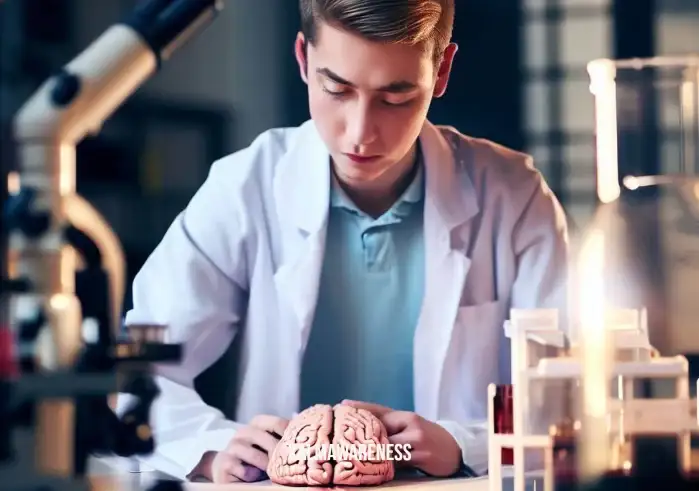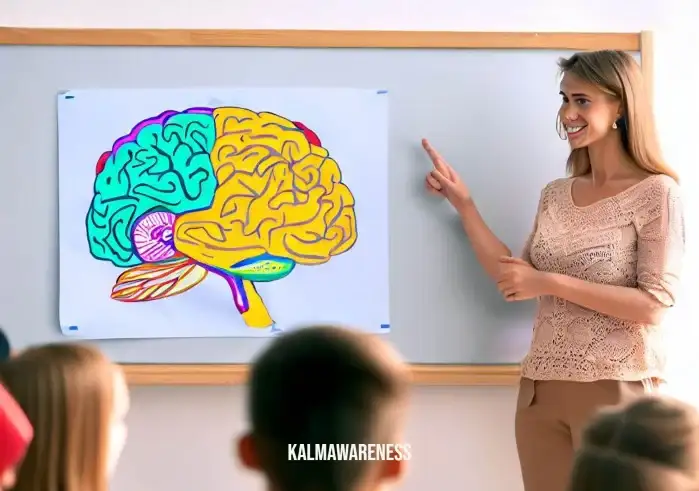Inside The Teenage Brain Worksheet: An Insight into Adolescent Development
Embarking on a fascinating journey, we delve into the intricate workings of the teenage brain. This voyage is guided by a unique tool: the Inside the Teenage Brain Worksheet.
Unraveling The Adolescent Mind
Teens, characterized by their curious minds and emotional flux, are undergoing one of the most significant phases of brain development. The adolescent brain is a marvelous concoction of neurological growth and hormonal changes, making it a central topic in neuroscience, psychology, and education.
This worksheet not only aids in comprehending these alterations but also cultivates an understanding of how they impact cognition, emotions, and decision-making. Embracing this tool allows us to foster a supportive and nurturing environment for our teenagers, tailoring their education to their unique needs.
Inside the Teenage Brain Worksheet is not just a tool; it’s a bridge connecting adults to the mystifying realm of teenagers. It answers the crucial questions: “Why does my teenager behave like this?”, “What is happening inside their brain?”, and “How can I better support them?”
“If we teach today’s students as we taught yesterday’s, we rob them of tomorrow.” – John Dewey
This quote speaks volumes about the importance of understanding and adapting to the changing landscape of teenage minds.
An Unprecedented Tool: The Inside the Teenage Brain Worksheet
The Inside the Teenage Brain Worksheet is a comprehensive guide designed to help adults understand the complex neurological changes occurring during adolescence. It emphasizes the importance of fostering a mindful and compassionate approach towards teenagers.
The worksheet is divided into various sections, each focusing on a different aspect of the teenage brain.
- Cognitive Development: It addresses the intellectual changes, giving insight into their developing thinking abilities, mental gears, and understanding the significance of their curiosity.
- Emotional Changes: It helps understand the emotional flux that is characteristic of adolescence, and the way it impacts their behavior and decision-making.
- Neurological Development: The worksheet explores the scientific perspective of these changes, linking it to the amazing workings of the brain.
In addition to these, the worksheet provides practical tips and strategies for adults to effectively communicate and connect with teenagers, fostering an environment of understanding, empathy, and growth.
“Understanding is the first step to acceptance, and only with acceptance can there be recovery.” – J.K. Rowling
While this quote was penned in a different context, it beautifully applies to the journey of understanding the teenage mind.
I invite you to continue to the next part of this article where we delve deeper into the cognitive, emotional, and neurological aspects of the teenage brain as detailed in our worksheet. Expect a fascinating exploration of the intricate and dynamic landscape of the adolescent mind!

The Anatomy of The Teenage Brain: An Insight into Its Unique Structure and Functioning
In the next phase of our exploration of the inside the teenage brain worksheet, we’ll focus on the anatomy and structure of the teenage brain, and how these factors contribute to unique adolescent behaviors and experiences.
The human brain is undeniably kind of a big deal. It’s a wondrous organ, whose structure and function is perhaps the most complex in the universe. Understanding its anatomy and functionality can provide valuable insights into why teenagers behave the way they do.
The Prefrontal Cortex: A Work in Progress
The prefrontal cortex, the area responsible for decision-making, reasoning, and impulse control, is still maturing during the teenage years. This partially explains why teenagers sometimes make impulsive decisions or struggle with evaluating the long-term consequences of their actions.
A fascinating concept to understand in this regard is the idea of ‘pruning’. Just as one would prune a tree to get rid of unnecessary branches and foster growth, the teenage brain undergoes a similar process. It discards the neural connections that are less used and strengthens those that are frequently used. This neuro-somatic mindfulness plays a significant role in shaping teenagers’ cognitive abilities and personality traits.
The Power of the Amygdala
The amygdala, the brain’s emotional center, matures faster than the prefrontal cortex. As such, when adolescents are processing emotions, they tend to rely more on the amygdala than the not-yet-fully-developed prefrontal cortex. This may result in more emotionally charged and less rational reactions to situations, leading to what we often interpret as ‘typical teenage behavior’.
Dopamine and the Teenage Brain
Dopamine, the ‘feel good’ neurotransmitter, also plays a significant role in the teenage brain. It’s linked with pleasure, reward, and risk-taking behaviors. Studies suggest that dopamine activity peaks during adolescence, which might explain their increased tendency towards thrill-seeking and exploratory behaviors.
“Understanding the brain… particularly a teenager’s brain, is like exploring a continent. There’s a lot of territory to cover, and you’re not quite sure where to start.” – Frances E. Jensen, The Teenage Brain
As we continue to venture further into the landscape of the teenage brain, remember that understanding the ‘why’ behind adolescent behaviors can help adults foster more compassionate and understanding relationships with teenagers.
In the next part of this article, we’ll delve into the role of education and environment in shaping the teenage brain. We’ll also touch upon how mindfulness practices, like those discussed in Wendy Hasenkamp’s works, can be beneficial during this developmental stage. Stay tuned!

The Role of Education and Environment in Shaping the Teenage Brain
As we navigate further inside the teenage brain worksheet, we’ll now examine the pivotal role that education and environment play in shaping the adolescent brain.
Adolescence: A Crucial Learning Phase
Adolescence is a prime time for learning and memory formation. The brain’s extraordinary plasticity during these years makes this a time of both great potential and vulnerability. Various elements in a teenager’s surroundings can enhance or impair the healthy growth of their brain.
The role of education becomes crucial during these formative years. An approach that encourages curiosity and questioning can enhance cognitive and emotional growth. To put it succinctly, there’s a close connection between different courses an example of the interconnectedness of courses, which can ignite a passion for lifelong learning.
The Influence of Teachers and Peer Group
Teachers and classmates significantly impact a teenager’s development. The encouragement from teachers, particularly, can have a lasting impact in adolescence. Peer influence, both positive and negative, can shape teenagers’ identities and behaviors, further underlining the importance of a positive and supportive environment.
Environmental Factors
Several environmental factors influence the teenage brain’s development, such as nutrition, physical activity, sleep, and even screen time. Balanced nutrition and regular physical activity promote healthy brain development, enhancing cognitive function and mood regulation. The often-undermined factor, sleep, plays a vital role in consolidating memory and learning.
Screen time, on the other hand, has been a topic of much debate. It’s worth mentioning that not all screen time is harmful. It’s the nature and extent of the screen exposure that determines its impact on the teenage brain.
Meditation and Mindfulness
Practicing mindfulness and meditation has been shown to have a profound impact on the teenage brain. Such practices can boost attention span, reduce stress, and promote emotional wellbeing. Schools incorporating mindfulness classes, like the Penn Mindfulness Class, into their curriculum are seeing positive results.
“The teen years are a time of opportunity and vulnerability; they can determine a lot about a person’s future. It’s important we do all we can to make sure that future is bright.” – Jay Giedd
As we explore deeper into the realms of the teenage brain, it’s crucial to appreciate the power of external influences on its development. A nurturing educational environment and a balanced lifestyle can significantly enhance a teenager’s brain’s potential.
Next, we’ll be looking at the potential challenges faced by teenagers and strategies to boost their wellbeing, including confidence-building courses like those offered near me and more.

Harnessing the Power of the Teenage Brain: Challenges and Solutions
In the third installment of our journey inside the teenage brain worksheet, we will tackle the challenges that adolescents face and some viable strategies to address these. We’ll focus on how we can harness the immense potential of the teenage brain.
The Challenges
Teenagers face numerous physical, emotional, and social changes that can lead to various challenges. From academic pressures to social anxieties, body image issues to struggles with self-esteem, the teen years are indeed tumultuous. The increase in brain connectivity during adolescence can sometimes lead to feeling overwhelmed or brain fog. This sensation of mental confusion can affect focus, memory, and mental clarity, affecting teenagers’ daily lives.
The Role of Confidence Building
One of the key solutions to tackle these challenges is building confidence. Confidence is integral to face adversity, overcome challenges, and believe in one’s capabilities. Locally, there are various confidence-building courses offered near me that can provide effective strategies for teenagers to enhance their self-esteem.
The Power of Mindfulness
Mindfulness can also play a pivotal role in helping teenagers navigate through these complex years. It can help teens stay grounded in the present moment, alleviate stress, and foster emotional stability. Becoming conscious: The Science of Mindfulness provides a more in-depth insight into how mindfulness can transform the teenage brain.
Importance of Personal Growth
Adolescence is also a time of immense personal growth. Encouraging teenagers to pursue their interests and hobbies, developing new skills, and setting personal goals can contribute to their overall development. Some schools even offer a personal growth stipend to facilitate this exploration.
Emotional Regulation
Another important aspect is emotional regulation. With the hormonal changes occurring during adolescence, teenagers may often experience intense emotions. Strategies like cognitive-behavioral techniques, mindfulness, and self-awareness can help teenagers navigate their emotional landscape.
Supporting Teens Through Their Journey
Parents, teachers, and caregivers play a crucial role in supporting teenagers through their journey. Encouragement, open communication, understanding, and patience can go a long way in helping teens find their footing in these critical years.
In the end, we must remember that every teenager’s journey is unique. Their struggles, challenges, and triumphs are their own. Understanding and compassion can pave the way for their transition into adulthood.

The Mental Health of The Teenage Brain and Tools for Improvement
As we journey inside the teenage brain worksheet, in the fourth chapter, we shift our focus towards understanding the mental health of the teenage brain and the tools that can be used for improvement.
Mental Health and The Teenage Brain
Mental health is a critical component of a teenager’s overall wellbeing. The rapid changes and development taking place inside the teenage brain can sometimes contribute to mental health challenges like anxiety, depression, and stress disorders. In this respect, a practical tool for understanding and managing mental health is Judson Brewer’s book, which delves into the concept of mindfulness and how it can aid in mental health management.
Neuro-Somatic Mindfulness
Another tool that can be beneficial is the practice of neuro-somatic mindfulness. This approach combines the understanding of neuroscience with the practice of mindfulness, allowing teenagers to better connect their mind with their body. This connection can assist in stress reduction and promote emotional regulation.
The Role of Physical Activity
Physical activity plays a significant role in maintaining mental health. It helps in the release of ‘feel good’ hormones and promotes better sleep, both of which can have a positive impact on a teenager’s mental state. Incorporating activities like yoga, dance, or sports can create a positive effect on the brain. To engage children in physical activity, incorporating movement books for preschoolers can be a starting point from an early age.
Creating a Supportive Environment
Another key element in promoting mental health is creating a supportive environment. This involves not just family, but also the educational institutions that play a significant role in a teenager’s life. Ensuring teachers offer encouragement, and creating a classroom environment that cares for the students (caring for classrooms) can have a substantial positive impact on their mental wellbeing.
The Importance of Sleep
Sleep is a crucial, often overlooked, aspect of mental health. The teenage brain undergoes numerous changes and growth during sleep. Lack of adequate sleep can lead to issues like mood swings, cognitive impairment, and lower academic performance. Thus, creating a good sleep routine can be invaluable in maintaining mental health.
Conclusion
Understanding the mental health aspect of the teenage brain is crucial in supporting adolescents’ overall development. Equipping them with the tools to manage their mental health can not only help them during their teenage years but can also lay a solid foundation for their adult lives.

Bonus Chapter: Harnessing the Power of the Teenage Brain
As a thank you for accompanying us on this in-depth journey through the chapters inside the teenage brain worksheet, we’ve prepared a special bonus chapter for you. Here, we will outline how to harness the unique strengths of the teenage brain, turning potential challenges into opportunities for growth and development.
Embracing Change and Novelty
The adolescent brain is primed for change and novelty. This period of their life is characterized by a drive to explore, experience, and learn new things. This enthusiasm for novelty is a double-edged sword; while it can sometimes lead to risky behaviors, it can also be channeled towards productive pursuits. Teachers, parents, and mentors can harness this curiosity and direct it towards meaningful learning experiences.
Building Confidence and Self-Esteem
Teenage years are a time of self-discovery, with teens shaping their identities and figuring out their place in the world. It’s also a period where they can be particularly sensitive to their self-image and peer opinions. This presents an opportunity to build their confidence and self-esteem through structured activities. Involvement in confidence-building courses can help adolescents improve their self-perception and resilience.
Encouraging Emotional Intelligence
With the hormonal changes occurring during adolescence, teenagers often experience heightened emotions. While this can lead to mood swings and impulsive behavior, it’s also an opportunity to nurture emotional intelligence. Tools such as the hand-brain model can help teenagers understand their emotional responses and build empathy, leading to improved social interactions.
Promoting Mindful Engagement
The teenage brain’s increased impulsivity can be mitigated by teaching mindfulness techniques. Encouraging adolescents to attend classes like the Penn mindfulness class can equip them with the tools to practice mindfulness, leading to better self-regulation and mental wellbeing.
Fostering Interconnectedness in Learning
One of the most unique aspects of the adolescent brain is its plasticity, making it a prime time for learning and developing complex skills. Education during this period can move beyond the traditional siloed approach to a more interconnected model. Emphasizing the interconnectedness of courses can make learning more engaging and effective for teenagers.
Thank you for joining us on this enlightening journey inside the teenage brain worksheet. We hope that this exploration has not only broadened your understanding of the complexities of the adolescent brain but also given you practical tools and insights to support the teens in your life.




